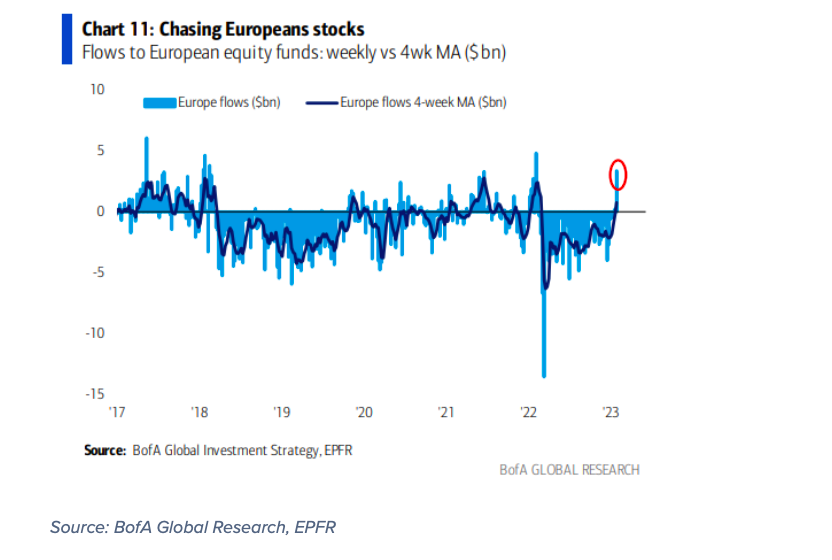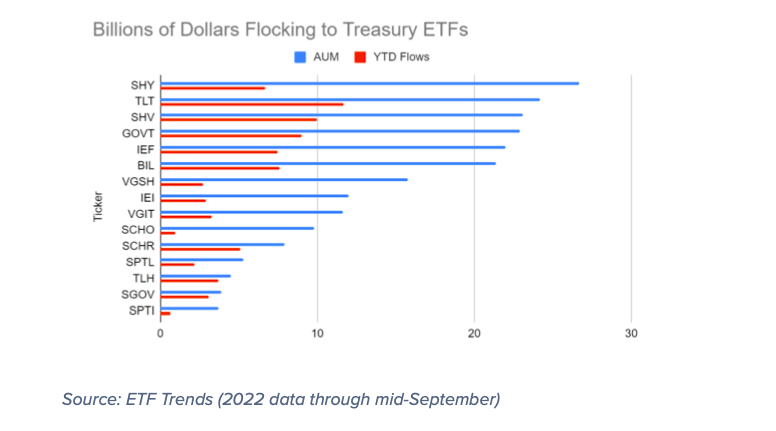The following research was contributed to by Christine Short, VP of Research at Wall Street Horizon.
- Declines across asset classes in 2022 may be a net positive for ETFs as investors repair and retool their portfolios
- Areas away from the S&P 500 are capturing flows while high yields in the Treasury market attract record-high idle cash
- At the same time, advisors may rethink how they allocate capital in 2023 given favorable relative costs and the tax benefits of ETFs versus SMAs
- With so many moving pieces, monitoring ETF trends will be key this year along with managing risk in the space
Last year’s market pain was ETFs’ gain. Big-time tax-loss harvesting allowed investors to sell losing mutual fund positions and purchase similar, often lower-cost, ETFs to improve their portfolios. It’s yet another tailwind for the ETF industry. Also consider that significant stock and bond market declines have not seemed to ding folks’ plans to continue putting money to work in various asset classes. According to one survey, 65% of retail investors intend to stick with their investment plans in 2023 while 29% expect to increase allocations.¹
An International Equity ETF Renaissance
And we have already seen significant inflows to areas that were not so hot in 2022. China’s economic re-opening and the sudden outperformance among European equities since Q4 last year has led to a rebound in net flows toward those once beleaguered regions. According to data from EPFR, Euro Area equities took in more than $3 billion in net flows during the final week of January – the best single week in a year following a streak of 49 weeks of outflows that was halted the week prior. Todd Rosenbluth, VettFi’s head of research, notes that Chinese equity ETFs have gained popularity this year amid the ongoing rebound in emerging market stocks.²
European Equity Funds Capture investors’ Dollars Following Strong Performance in Q4

Big Yields, Big Flows
What’s more, higher bond market interest rates has led to significant money moving into short-dated Treasury ETFs. Expect that trend to continue as the Fed notches up its policy rate to the highest levels in more than 15 years to combat inflation. Fixed-income investors will finally be rewarded with positive real yields without stepping out far on the risk spectrum. A popular trade throughout the second half of last year and so far in 2023 is to play it safe in short-term Treasury ETFs.
In fact, the iShares 1-3 Year Treasury Bond ETF (SHY) is now neck and neck with the iShares 20+ Year Treasury Bond ETF (TLT) for the largest Treasury ETF by AUM. Schwab’s suite of inexpensive ETFs also keeps gaining steam – the Schwab Short-Term U.S. Treasury ETF (SCHO) raked in almost $2.5 billion over the first few weeks of 2023, according to flow data from VettaFi. With recession worries ebbing, but still present, this so-called barbell strategy that pounces on high near-term yields and long-duration bonds would hypothetically work in an economic downturn.
Rates on the Rise, Money Pours into Treasury ETFs

More Room to Run? Investors’ Record High Dry Powder.
Amid investor allocations shifting toward somewhat aggressive international shares and to risk-off Treasury ETFs, the landscape is shifting. No longer are people fixated on simply owning the S&P 500 or a broad U.S. stock market ETF. This new regime stands to benefit other asset classes and sub-asset classes, along with many ETF issuers. And there’s still opportunity for more money to shift into tax-efficient ETFs. Consider that there is more cash parked on the sidelines in money market mutual funds today than ever before, according to data from the Investment Company Institute as of January 26, 2023.³ At just shy of $5 trillion, that dry powder may eventually get put to work in equity and fixed-income ETFs.
Trend to Watch: RIA SMAs Converting to ETFs
Pivoting away from stocks and bonds, there is a broader bullish wave for ETFs. The tide may be moving out for traditional separately managed accounts (SMAs) and coming in for ETFs. Financial advisors no doubt recognize the benefits of the ETF wrapper, but for years it was assumed that it was only a boost for ETF issuers, not independent RIAs. Now, though, through technology and industry evolution, it’s easier and cheaper to launch an ETF to replace an SMA. Better tax treatment, fee insulation, making complex strategies easier to hold, and even, as VettaFi notes, the ability to hold alternative investments within retirement accounts, are all upsides to ETFs relative to SMAs. This is one theme we will be keeping our eyes on this year.
Wall Street Horizon’s ETF Data Coverage
Having the best data ETF data is paramount to managing risk. Wall Street Horizon is known for our award-winning corporate event data coverage for institutional investors, quant traders, academics, and portfolio managers. We’ve been beefing up our ETF database as the industry continues to expand.
The Bottom Line
2022 was like hitting the reset button for investors. Steep losses in stocks and across the bond market allowed people to reassess their allocations. Heavy tax-loss selling late in the year prompted money to be allocated away from mutual funds and into lower-cost, more tax-efficient ETFs. Moreover, with a rebound in foreign equities, investors are finally putting new money to work in regions that were unloved for years. Meanwhile, higher yields today and economic jitters attract cash to both the short and long ends of the Treasury curve. These trends may persist with record cash on the sidelines, too. At a higher level, wealth managers will likely be increasing their use of ETFs as costs retreat.
Sources:
¹ https://www.cnbc.com/2022/12/08/retail-investors-say-stock-market-will-bottom-in-2023-finimize-survey.html
² https://www.etftrends.com/the-etfs-outside-the-big-three-pulling-in-cash/
³ https://www.ici.org/research/stats/mmf
For more information on the data sourced in this report, please email: info@wallstreethorizon.com
Wall Street Horizon provides institutional traders and investors with the most accurate and comprehensive forward-looking event data. Covering 9,000 companies worldwide, we offer more than 40 corporate event types via a range of delivery options from machine-readable files to API solutions to streaming feeds. By keeping clients apprised of critical market-moving events and event revisions, our data empowers financial professionals to take advantage of or avoid the ensuing volatility.

Christine Short, VP of Research at Wall Street Horizon, is focused on publishing research on Wall Street Horizon event data covering 9,000 global equities in the marketplace. Over the past 15 years in the financial data industry, her research has been widely featured in financial news outlets including regular appearances on networks such as CNBC and Fox to talk corporate earnings and the economy.
Twitter: @ChristineLShort
The author may hold positions in mentioned securities. Any opinions expressed herein are solely those of the author, and do not in any way represent the views or opinions of any other person or entity.








